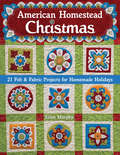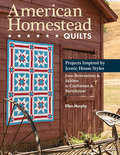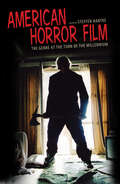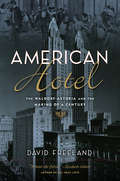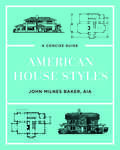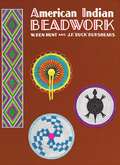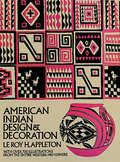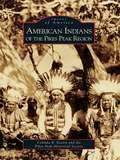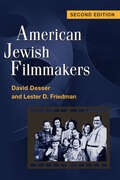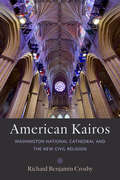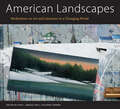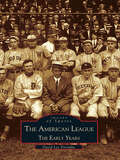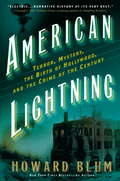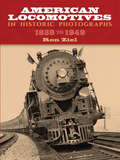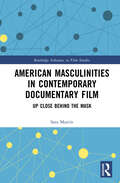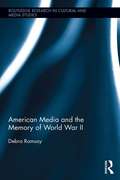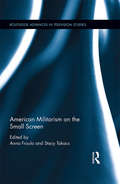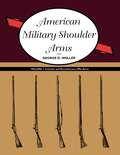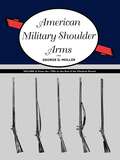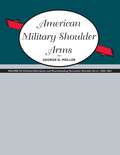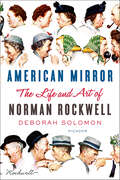- Table View
- List View
American Homestead Christmas: 21 Felt & Fabric Projects for Homemade Holidays
by Ellen MurphySimple to stitch, perfect for gifts: Make your Christmas crafty with handmade ornaments, stockings, tree skirts, and more!American Homestead is back again—this time with charming small projects you can sew anytime, anywhere. Ellen Murphy shares twenty-one embroidered felt and quilted designs for the holidays in her signature folk-art style. These classic patterns can also be stitched up in alternate colors to be suitable all year round. Festive projects, from all-new felt ornaments to cheerful stockings, make beautiful tree trimmings and treasured gifts for family and friends.
American Homestead Quilts: Projects Inspired by Iconic House Styles from Brownstone & Saltbox to Craftsman & Farmhouse
by Ellen MurphyPair timeless quilt designs and classic American homes with this book featuring “lyrical commentary [and] clear how-tos” (Publishers Weekly).Designer Ellen Murphy has created unique quilts inspired by the colors and shapes of American houses. From colonial farmhouses to brownstones, these quilts will beautify any décor. This book includes patterns and complete instructions for nine traditional pieced quilts in a variety of sizes and color palettes, plus inspirational photos featuring iconic American homes. Classic-styled quilts are perfect for building your sewing skills: Begin with simple squares and work your way up to more challenging diamond patterns.
American Horror Film: The Genre at the Turn of the Millennium
by Steffen HantkeCreatively spent and politically irrelevant, the American horror film is a mere ghost of its former self—or so goes the old saw from fans and scholars alike. Taking on this undeserved reputation, the contributors to this collection provide a comprehensive look at a decade of cinematic production, covering a wide variety of material from the last ten years with a clear critical eye. Individual essays profile the work of up-and-coming director Alexandre Aja and reassess William Malone’s much-maligned Feardotcom in the light of the torture debate at the end of President George W. Bush’s administration. Other essays look at the economic, social, and formal aspects of the genre; the globalization of the US film industry; the alleged escalation of cinematic violence; and the massive commercial popularity of the remake. Some essays examine specific subgenres—from the teenage horror flick to the serial killer film and the spiritual horror film—as well as the continuing relevance of classic directors such as George A. Romero, David Cronenberg, John Landis, and Stuart Gordon. Essays deliberate on the marketing of nostalgia and its concomitant aesthetic and on the curiously schizophrenic perspective of fans who happen to be scholars as well. Taken together, the contributors to this collection make a compelling case that American horror cinema is as vital, creative, and thought-provoking as it ever was.
American Hotel: The Waldorf-Astoria and the Making of a Century
by David FreelandCompleted in 1931, New York’s Waldorf-Astoria towers over Park Avenue as an international landmark and a masterpiece of Art Deco architecture. A symbol of elegance and luxury, the hotel has hosted countless movie stars, business tycoons, and world leaders over the past ninety years. American Hotel takes us behind the glittering image to reveal the full extent of the Waldorf’s contribution toward shaping twentieth-century life and culture. Historian David Freeland examines the Waldorf from the opening of its first location in 1893 through its rise to a place of influence on the local, national, and international stage. Along the way, he explores how the hotel’s mission to provide hospitality to a diverse range of guests was put to the test by events such as Prohibition, the anticommunist Red Scare, and civil rights struggles. Alongside famous guests like Frank Sinatra, Martin Luther King, Richard Nixon, and Eleanor Roosevelt, readers will meet the lesser-known men and women who made the Waldorf a leader in the hotel industry and a key setting for international events. American Hotel chronicles how institutions such as the Waldorf-Astoria played an essential role in New York’s growth as a world capital.
American House Styles (Second edition): A Concise Guide
by John Milnes Baker“An engaging historical account and an attractive, practical resource.” —Booklist Colonial, Neoclassical, Queen Anne, Craftsman—what distinguishes one architectural style from another? This unique book will allow readers to recognize the architectural features and style of virtually any house they encounter. Here, architect John Milnes Baker explains the historical, cultural, and technical influences that shaped each of these styles and many more. Organized in periods, from Early Colonial (1600–1715) to the Modern Movement (1920–60) and beyond, this tour of America’s varied residential architecture is rendered in elevation drawings that precisely illustrate the key characteristics of each style. Nearly 25 years since the original publication of American House Styles, this updated edition includes a new preface and house styles from the mid-1990s to the present—from the rise and fall of the McMansion to energy-efficient, regionally influenced homes. The illustrations, now in color, are more delightful than ever in a new, larger format. This a must-have volume for anyone interested in architecture or adding a bit of style to their home.
American Idol: The Untold Story
by Richard RushfieldThe currency is fame, and it's bigger than money, more desired than power. Each season American Idol delivers on a promise whose epic scope is unparalleled in the annals of competition: to take an unknown dreamer from the middle of America and turn him or her into a genuine star. It has become not only the biggest show on television, but the biggest force in all of entertainment; its alumni dominate the recording charts and Broadway, win Academy Awards, and sweep up Grammys. In fact, American Idol has reshaped the very idea of celebrity. But it didn't start out that way. When the little singing contest debuted as a summer replacement on the U.S. airwaves, it was packed between reruns and low-cost filler. The promise that it would find America's next pop star produced a hearty round of guffaws from the country's media critics. Now, some ten years and millions of records later, no one is laughing. American Idol: The Untold Story chronicles the triumphs and travails, the harrowing backstage drama and the nail-biting onstage battles that built this revolutionary show. In this revealing book, veteran journalist Richard Rushfield goes deeper inside the circus than any reporter ever has. Candid interviews with Idol alumni, including Simon Fuller and Simon Cowell, shed new light on the show that changed the entertainment industry. And because Rushfield had full access to the people who created the show, starred in it, and kept it atop the pop culture pyramid, this book is the first to take Americans behind the curtain and tell what has really been happening on the world's most watched and speculated-about stage.
American Imperial Pastoral: The Architecture of US Colonialism in the Philippines
by Rebecca Tinio MckennaIn 1904, renowned architect Daniel Burnham, the Progressive Era urban planner who famously “Made No Little Plans,” set off for the Philippines, the new US colonial acquisition. Charged with designing environments for the occupation government, Burnham set out to convey the ambitions and the dominance of the regime, drawing on neo-classical formalism for the Pacific colony. The spaces he created, most notably in the summer capital of Baguio, gave physical form to American rule and its contradictions. In American Imperial Pastoral, Rebecca Tinio McKenna examines the design, construction, and use of Baguio, making visible the physical shape, labor, and sustaining practices of the US’s new empire—especially the dispossessions that underwrote market expansion. In the process, she demonstrates how colonialists conducted market-making through state-building and vice-versa. Where much has been made of the racial dynamics of US colonialism in the region, McKenna emphasizes capitalist practices and design ideals—giving us a fresh and nuanced understanding of the American occupation of the Philippines.
American Indian Beadwork
by W. Ben Hunt J.F. "Buck" BurshearsOne of the original classical books on Indian beadwork art. Includes detailed directions for various beading stitches as well as making and stringing a loom.
American Indian Design and Decoration
by Le Roy AppletonThe most original and most powerful design art produced in the Western Hemisphere is also its most indigenous: that of the Indian, in innumerable cultures existing from prehistory to the arrival of the white man, reaching from the Arctic Circle to Tierra del Fuego. It owes, of course, nothing to Europe or the classical Orient. It is tremendous in variety, differing region by region, era by era, often tribe by tribe. It is always vigorously distinctive. This book, 20 years in preparation, shows us that art in all its profuse diversity and in the almost numberless crafts for which the American Indian is famous. Well over 700 examples, drawn with painstaking care, are shown: representations of flora and fauna, men and gods, earth and sky; symbols of clan and tribe, religion and magic; formal designs from the primal to the highly intricate. They appear in examples of basketry, weaving, pottery, sculpture, painting, lapidary work, masks, drumheads, weapons, apparel, beadwork, goldwork, blankets, ponchos, and many other forms. The arts and crafts of Inca, Tiahuanaco, Chimú, Maya, Axtec, Zapotec, Totonac, Mixtec, Navaho, Zuni, Hopi, Apache, Cherokee, Creek, Winnebago, Dakota, Blackfoot, Nez Percé, Cheyenne, Crow, Sioux, Cochiti, Haida, Bellacoola, and others known and unknown are here. Each section is preceded by a page of typical motifs of an area, making it easy to isolate the design elements. In addition, the lore and tradition behind the designs are told in a text reproducing the Indians' own stories and songs. Separate indices simplify locating the work of particular tribes and regions. Craftspeople will find in this book a prolific source of timeless, eternally valid design ideas representing years of research in museums all over the hemisphere; for the graphic artist there is a wealth of material than can be adapted directly to his needs. All those interested in the Americans who preceded us on these continents will find this work unique.
American Indians of the Pikes Peak Region
by Pikes Peak Historical Society Celinda R. KaelinThousands of years before Zebulon Pike's name became attached to this famous mountain, Pikes Peak was home to indigenous people. These First Nations left no written record of their sojourn here, but what they did leave were stone circles, carefully crafted arrowheads and stone tools, enigmatic petroglyphs, and culturally scarred trees. In the 1500s, Spanish explorers documented their locations, language, and numbers. In the 1800s, mountain men and official explorers such as Pike, Fremont, and Long also wrote about these First Nations. Comanche, Apache, Arapaho, Cheyenne, Kiowa, and Lakota made incursions into the region. These nations contested Ute land possession, harvested the abundant wildlife, and paid homage to the powerful spirits at Garden of the Gods and Manitou Springs. Today Ute Indians return to Garden of the Gods and to Pikes Peak each year to perform their sacred Sundance Ceremony.
American Jewish Filmmakers
by Lester D. Friedman David DesserWoody Allen, Mel Brooks, Sidney Lumet, and Paul Mazursky, all sons of East European Jews, remain among the most prominent contemporary American film directors. In this revised, updated second edition of American Jewish Filmmakers, David Desser and Lester D. Friedman demonstrate how the Jewish experience gives rise to an intimately linked series of issues in the films of these and other significant Jewish directors. The effects of the Holocaust linger, both in gripping dramatic form (Mazursky's Enemies, a Love Story) and in black comedy (Brooks's The Producers). In his trilogy consisting of Serpico, Prince of the City, and Q&A, Lumet focuses on the failure of society's institutions to deliver social justice. Woody Allen portrays urban life and family relationships (Manhattan and Hannah and Her Sisters), sometimes with a nostalgic twist (Radio Days). This edition concludes with a newly written discussion of the careers of other prominent Jewish filmmakers such as Steven Spielberg, Barry Levinson, Brian Singer, and Darren Aronofsky.
American Kairos: Washington National Cathedral and the New Civil Religion
by Richard Benjamin CrosbyA history of Washington National Cathedral and the theory of an American civil religion.In 1792, Pierre Charles L'Enfant, the first city planner of Washington, DC, introduced the idea of a "great church for national purposes." Unlike L'Enfant's plans for the White House, the US Capitol, and the National Mall, this grand temple to the republic never materialized. But in 1890, the Episcopal Church began planning what is known today as Washington National Cathedral. In American Kairos, Richard Benjamin Crosby chronicles the history of not only the building but also the idea that animates it, arguing that the cathedral is a touchstone site for the American civil religion—the idea that the United States functions much like a religion, with its own rituals, sacred texts, holy days, and so on. He shows that the National Cathedral can never be the church L'Enfant envisioned, but it can be a starting point for studying the conflicts over belonging, ideology, and America's place in the world that define the American civil religion. By examining correspondence between L'Enfant, George Washington, Thomas Jefferson, and others, and by diving into Washington National Cathedral's archives, Crosby uncovers a crucial gap in the formation of the nation's soul. While L'Enfant's original vision was never realized, Washington National Cathedral reminds us that perhaps it can be. The cathedral is one of the great rhetorical and architectural triumphs in the history of American religion. Without government mandate or public vote, it has claimed its role as America's de facto house of worship, a civil religious temple wherein Americans conduct some of their highest, holiest rituals, including state funerals and National Day of Prayer services.
American Landscapes: Meditations on Art and Literature in a Changing World (University of Mississippi Museum and Historic Houses Series)
by Ann J. Abadie and J. Richard GruberAmerican Landscapes: Meditations on Art and Literature in a Changing World is a major contemporary survey of landscapes in art and literature of the United States, especially the American South. Inspired by William Dunlap’s extraordinary landscape Meditations on the Origins of Agriculture in America and a collection of forty paintings and photographs by Southern artists, this volume brings together artists, authors, and scholars to present new perspectives on art and literature both past and present. The volume includes art and text from artists John Alexander, Jason Bouldin, William Dunlap, Carlyle Wolfe Lee, Ke Francis, Linda Burgess, Randy Hayes; photographers Sally Mann, Ed Croom, and Huger Foote; museum directors Betsy Bradley, Jane Livingston, and Julian Rankin; and authors W. Ralph Eubanks, John Grisham, J. Richard Gruber, Jessica B. Harris, Lisa Howorth, Julia Reed, Natasha Trethewey, Curtis Wilkie, Joseph M. Pierce, and Drew Gilpin Faust. This diverse group explores major eras of American history portrayed in Dunlap’s painting, a landscape that evokes the displacement and genocide of Native Americans, the enslavement of Africans, the Civil War, and William Faulkner’s fiction. They examine the history of landscape art in America, connecting art with the works of major writers like William Faulkner, Eudora Welty, Natasha Trethewey, and Jesmyn Ward. In eighteen new essays written during the pandemic and since the events of January 6, 2021, the essayists emphasize how the key issues Dunlap addressed in his 1987 artwork have become part of the national discourse and make his work even more vital today.
American League: The Early Years (Images of Sports)
by David Lee PorembaShowcasing two influential decades of home runs, stolen bases, and national heroes, David Lee Poremba invites us to take an in-depth look back through the history of baseball in The American League: The Early Years. Poremba has collected over 200 images and captions in this new volume that documents the fledgling American League and its charismatic teams, from its creation in 1901 to its lively rebirth as America's Pastime in 1920. Founded nearly a century ago when Western League President Ban Johnson renamed the circuit in 1900, the American League defied the norm. Amidst the struggles to name a National League president and the expiration of the National Agreement which governed the baseball world, Johnson leapt into open competition for players and fans. Seen in this extensive photographic collection are the historic players lured away from the National League and into the higher paying American League, including Ty Cobb, "Shoeless" Joe Jackson, "Wee" Willie Keeler, Cy Young, Nap Lajoie, and many others. With the introduction of the cork-centered baseball in 1910 and the advent of the Sultan of Swat, Babe Ruth, the game of baseball would change forever.
American Lightning
by Howard BlumIt was an explosion that reverberated across the country--and into the very heart of early-twentieth-century America. On the morning of October 1, 1910, the walls of the Los Angeles Times Building buckled as a thunderous detonation sent men, machinery, and mortar rocketing into the night air. When at last the wreckage had been sifted and the hospital triage units consulted, twenty-one people were declared dead and dozens more injured. But as it turned out, this was just a prelude to the devastation that was to come.In American Lightning, acclaimed author Howard Blum masterfully evokes the incredible circumstances that led to the original "crime of the century"--and an aftermath more dramatic than even the crime itself. With smoke still wafting up from the charred ruins, the city's mayor reacts with undisguised excitement when he learns of the arrival, only that morning, of America's greatest detective, William J. Burns, a former Secret Service man who has been likened to Sherlock Holmes. Surely Burns, already world famous for cracking unsolvable crimes and for his elaborate disguises, can run the perpetrators to ground. Through the work of many months, snowbound stakeouts, and brilliant forensic sleuthing, the great investigator finally identifies the men he believes are responsible for so much destruction. Stunningly, Burns accuses the men--labor activists with an apparent grudge against the Los Angeles Times's fiercely anti-union owner--of not just one heinous deed but of being part of a terror wave involving hundreds of bombings. While preparation is laid for America's highest profile trial ever--and the forces of labor and capital wage hand-to-hand combat in the streets--two other notable figures are swept into the drama: industry-shaping filmmaker D.W. Griffith, who perceives in these events the possibility of great art and who will go on to alchemize his observations into the landmark film The Birth of a Nation; and crusading lawyer Clarence Darrow, committed to lend his eloquence to the defendants, though he will be driven to thoughts of suicide before events have fully played out.Simultaneously offering the absorbing reading experience of a can't-put-it-down thriller and the perception-altering resonance of a story whose reverberations continue even today, American Lightning is a masterpiece of narrative nonfiction.From the Hardcover edition.
American Lightning
by Howard BlumIt was an explosion that reverberated across the country--and into the very heart of early-twentieth-century America. On the morning of October 1, 1910, the walls of the Los Angeles Times Building buckled as a thunderous detonation sent men, machinery, and mortar rocketing into the night air. When at last the wreckage had been sifted and the hospital triage units consulted, twenty-one people were declared dead and dozens more injured. But as it turned out, this was just a prelude to the devastation that was to come.In American Lightning, acclaimed author Howard Blum masterfully evokes the incredible circumstances that led to the original "crime of the century"--and an aftermath more dramatic than even the crime itself. With smoke still wafting up from the charred ruins, the city's mayor reacts with undisguised excitement when he learns of the arrival, only that morning, of America's greatest detective, William J. Burns, a former Secret Service man who has been likened to Sherlock Holmes. Surely Burns, already world famous for cracking unsolvable crimes and for his elaborate disguises, can run the perpetrators to ground. Through the work of many months, snowbound stakeouts, and brilliant forensic sleuthing, the great investigator finally identifies the men he believes are responsible for so much destruction. Stunningly, Burns accuses the men--labor activists with an apparent grudge against the Los Angeles Times's fiercely anti-union owner--of not just one heinous deed but of being part of a terror wave involving hundreds of bombings. While preparation is laid for America's highest profile trial ever--and the forces of labor and capital wage hand-to-hand combat in the streets--two other notable figures are swept into the drama: industry-shaping filmmaker D.W. Griffith, who perceives in these events the possibility of great art and who will go on to alchemize his observations into the landmark film The Birth of a Nation; and crusading lawyer Clarence Darrow, committed to lend his eloquence to the defendants, though he will be driven to thoughts of suicide before events have fully played out.Simultaneously offering the absorbing reading experience of a can't-put-it-down thriller and the perception-altering resonance of a story whose reverberations continue even today, American Lightning is a masterpiece of narrative nonfiction.From the Hardcover edition.
American Lightning: Terror, Mystery, and the Birth of Hollywood
by Howard BlumIt was an explosion that reverberated across the country--and into the very heart of early-twentieth-century America. On the morning of October 1, 1910, the walls of the Los Angeles Times Building buckled as a thunderous detonation sent men, machinery, and mortar rocketing into the night air. When at last the wreckage had been sifted and the hospital triage units consulted, twenty-one people were declared dead and dozens more injured. But as it turned out, this was just a prelude to the devastation that was to come. In American Lightning, acclaimed author Howard Blum masterfully evokes the incredible circumstances that led to the original "crime of the century"--and an aftermath more dramatic than even the crime itself. With smoke still wafting up from the charred ruins, the city's mayor reacts with undisguised excitement when he learns of the arrival, only that morning, of America's greatest detective, William J. Burns, a former Secret Service man who has been likened to Sherlock Holmes. Surely Burns, already world famous for cracking unsolvable crimes and for his elaborate disguises, can run the perpetrators to ground. Through the work of many months, snowbound stakeouts, and brilliant forensic sleuthing, the great investigator finally identifies the men he believes are responsible for so much destruction. Stunningly, Burns accuses the men--labor activists with an apparent grudge against the Los Angeles Times' fiercely anti-union owner--of not just one heinous deed but of being part of a terror wave involving hundreds of bombings. While preparation is laid for America's highest profile trial ever--and the forces of labor and capital wage hand-to-hand combat in the streets--two other notable figures are swept into the drama: industry-shaping Filmmaker D. W. Griffith, who perceives in these events the possibility of great art and who will go on to alchemize his observations into the landmark film The Birth of a Nation; and crusading lawyer Clarence Darrow, committed to lend his eloquence to the defendants, though he will be driven to thoughts of suicide before events have fully played out. Simultaneously offering the absorbing reading experience of a can't-put-it-down thriller and the perception-altering resonance of a story whose reverberations continue even today, American Lightning is a masterpiece of narrative nonfiction.
American Locomotives in Historic Photographs: 1858 to 1949
by Ron ZielThis rare collection of 126 "builder portraits" of American locomotives offers an exciting cavalcade of images that chronicle the momentous rise of steam locomotive power in America. Builder portraits are especially prized by railway historians because they are the exacting official photographs of new models taken before repairs, alterations, and weathering altered their original appearance. The builder portraits reprinted here were selected from the William A. Rogers collection, a priceless archive of images documenting the history of American steam locomotion from the pre-Civil War era to the mid-20th century. While the accent in this book is on the oldest and rarest photographs in the Rogers collection, many modern portraits are included as well to demonstrate how highly developed the American steam locomotive had become before the advent of dieselization. Among the engines depicted are the España, a diminutive model built for the Spanish government in 1858; engine no. 216 of the Pennsylvania Railroad, a "fearsome apparition of Gothic character" built in 1861; the Chimbote Emilia, an inspection engine built for railroad company officials in 1868 that is considered a masterpiece of the engine builder's art; and a Union Pacific 1940s' "Big Boy," the largest and heaviest type of steam locomotive ever built.Clearly, builder portraits are the most revealing record possible of the evolution of the American steam locomotive. This rich selection offers railroading historians and enthusiasts a peerless record of a great age in railway history. Railroading expert Ron Zeil's introduction and captions provide readers with a brief railroading background, a commentary on the art of the builder portrait and key details on each locomotive depicted.
American Masculinities in Contemporary Documentary Film: Up Close Behind the Mask (Routledge Advances in Film Studies)
by Sara MartínMost documentaries deal with men, but what do they actually say about masculinity? In this groundbreaking volume Sara Martín analyses more than forty 21st-century documentaries to explore how they represent American men and masculinity. From Jennifer Siebel Newsom’s The Mask You Live In to Raoul Peck’s I Am Not Your Negro, this volume explores sixteen different faces of American masculinity: the good man, the activist, the politician, the whistleblower, the criminal, the sexual abuser, the wrongly accused, the dependent man, the soldier, the capitalist, the adventurer, the sportsman, the architect, the photographer, the musician, and the writer. The collective portrait drawn by the documentaries discloses a firm critical stance against the contradictions inherent in patriarchy, which makes American men promises of empowerment it cannot fulfill. The filmmakers’ view of American masculinity emphasizes the vulnerability of disempowered men before the abuses of the patriarchal system run by hegemonic men and a loss of bearings about how to be a man after the impact of feminism, accompanied nonetheless by a celebration of resilient masculinity and of the good American man. Firmly positioning documentaries as an immensely flexible, relevant tool to understand 21st-century American men and masculinity, their past, present, and future, this book will interest students and scholars of film studies, documentary film, American cultural studies, gender, and masculinity.
American Media and the Memory of World War II (Routledge Research in Cultural and Media Studies)
by Debra RamsayFor three generations of Americans, World War II has been a touchstone for the understanding of conflict and of America’s role in global affairs. But if World War II helped shape the perception of war for Americans, American media in turn shape the understanding and memory of World War II. Concentrating on key popular films, television series, and digital games from the last two decades, this book explores the critical influence World War II continues to exert on a generation of Americans born over thirty years after the conflict ended. It explains how the war was configured in the media of the wartime generation and how it came to be repurposed by their progeny, the Baby Boomers. In doing so, it identifies the framework underpinning the mediation of World War II memory in the current generation’s media and develops a model that provides insight into the strategies of representation that shape the American perspective of war in general.
American Militarism on the Small Screen (Routledge Advances in Television Studies)
by Anna Froula Stacy TakacsAnna Froula is Associate Professor of Film Studies in the Department of English at East Carolina University, USA Stacy Takacs is Associate Professor and Director of American Studies at Oklahoma State University, USA
American Military Shoulder Arms, Volume I: Colonial and Revolutionary War Arms
by George D. MollerAmerican Military Shoulder Arms, Volume I: Colonial and Revolutionary War Arms focuses on the arms used from the early exploratory period throughout the colonial period and the American Revolution. Arranged chronologically, it contains definitive descriptions of the pre-flintlock and flintlock shoulder arms used in North America and detailed accounts of the development and progression of military regulation shoulder arms of the major colonial powers from the early eighteenth century through the Revolutionary War. Lavishly illustrated with more than four hundred vivid photographs of muskets, rifles, carbines, and other arms, this book offers an intelligent analysis of the shoulder arms procured and used by the colonists, colonial and state governments, and the Continental Congress.
American Military Shoulder Arms, Volume II: From the 1790s to the End of the Flintlock Period
by George D. MollerNew data surrounding the procurement and modifications of arms produced by the national armories, and under federal contract procured by the individual states and by individual members of militias, is presented here for the first time. This information, interwoven with military, political, economic, and social factors, results in new and better definitions and a clearer understanding of the arms&’ historical context. Though this work focuses on military flintlock shoulder arms, details on the federal government&’s procurement of arms for Indians during rapidly changing military policies of the period is also included. American Military Shoulder Arms, Volume II, contains more than three hundred photographs. As with the previous volume, Volume II is written primarily for students of arms, but also contains material of interest to historians, museum specialists, collectors, and dealers of antique arms.
American Military Shoulder Arms, Volume III: Flintlock Alterations and Muzzleloading Percussion Shoulder Arms, 1840-1865
by George D. MollerThis third volume in Moller&’s authoritative reference work describes muzzleloading percussion shoulder arms procured by the U.S. government for issue to federal and state armed forces in the period that includes the Civil War. These twenty-five years were an exciting time in the history of shoulder arms. During the 1840s, only a handful of American manufacturers were capable of producing significant quantities of arms having fully interchangeable components. By the early 1850s, at least one firm was producing rifles with close enough tolerances to be considered fully interchangeable. And thanks to the invention of the expanding bullet, rifled arms could be used by an army&’s entire infantry. For the first time, line infantry were equipped with arms capable of rapid reloading and of consistently hitting a man-sized target at distances as great as three hundred yards. Like the first two volumes of American Military Shoulder Arms, this exhaustive reference work will be a must for serious arms collectors, dealers, and museum specialists.
American Mirror: The Life and Art of Norman Rockwell
by Deborah SolomonA NEW YORK TIMES BOOK REVIEW NOTABLE BOOK OF THE YEAR A FINALIST FOR THE LOS ANGELES TIMES BOOK PRIZE IN BIOGRAPHY AND SHORTLISTED FOR THE PEN/JACQUELINE BOGRAD WELD AWARD FOR BIOGRAPHY"Welcome to Rockwell Land," writes Deborah Solomon in the introduction to this spirited and authoritative biography of the painter who provided twentieth-century America with a defining image of itself. As the star illustrator of The Saturday Evening Post for nearly half a century, Norman Rockwell mingled fact and fiction in paintings that reflected the we-the-people, communitarian ideals of American democracy. Freckled Boy Scouts and their mutts, sprightly grandmothers, a young man standing up to speak at a town hall meeting, a little black girl named Ruby Bridges walking into an all-white school—here was an America whose citizens seemed to believe in equality and gladness for all.Who was this man who served as our unofficial "artist in chief" and bolstered our country's national identity? Behind the folksy, pipe-smoking façade lay a surprisingly complex figure—a lonely painter who suffered from depression and was consumed by a sense of inadequacy. He wound up in treatment with the celebrated psychoanalyst Erik Erikson. In fact, Rockwell moved to Stockbridge, Massachusetts so that he and his wife could be near Austen Riggs, a leading psychiatric hospital. "What's interesting is how Rockwell's personal desire for inclusion and normalcy spoke to the national desire for inclusion and normalcy," writes Solomon. "His work mirrors his own temperament—his sense of humor, his fear of depths—and struck Americans as a truer version of themselves than the sallow, solemn, hard-bitten Puritans they knew from eighteenth-century portraits."Deborah Solomon, a biographer and art critic, draws on a wealth of unpublished letters and documents to explore the relationship between Rockwell's despairing personality and his genius for reflecting America's brightest hopes. "The thrill of his work," she writes, "is that he was able to use a commercial form [that of magazine illustration] to thrash out his private obsessions." In American Mirror, Solomon trains her perceptive eye not only on Rockwell and his art but on the development of visual journalism as it evolved from illustration in the 1920s to photography in the 1930s to television in the 1950s. She offers vivid cameos of the many famous Americans whom Rockwell counted as friends, including President Dwight Eisenhower, the folk artist Grandma Moses, the rock musician Al Kooper, and the generation of now-forgotten painters who ushered in the Golden Age of illustration, especially J. C. Leyendecker, the reclusive legend who created the Arrow Collar Man.Although derided by critics in his lifetime as a mere illustrator whose work could not compete with that of the Abstract Expressionists and other modern art movements, Rockwell has since attracted a passionate following in the art world. His faith in the power of storytelling puts his work in sync with the current art scene. American Mirror brilliantly explains why he deserves to be remembered as an American master of the first rank.
